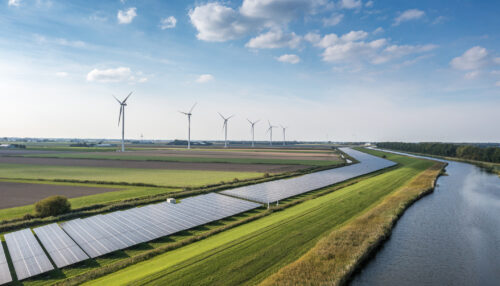
How Regional Energy Hubs Like Pennsylvania Are Shaping the Future of U.S. Data Center Infrastructure
August 27, 2025
By: John Bolakas
With 20% of U.S. natural gas production, strong nuclear energy capacity, and significant water resources, Pennsylvania is emerging as a model location for how regional energy hubs will lead AI Data Center infrastructure investments. More than $90 billion in recent commitments from Blackstone, Google, FirstEnergy, CoreWeave, and others show just how quickly investment is accelerating. At the Pennsylvania Energy and Innovation Summit, one message was clear: the race to power data centers is on, AI technology demands gigawatts of new power, and the timeline to produce it is urgent.
In this blog, we’ve outlined how energy-rich regions are evolving through energy-first planning, faster permitting, early stakeholder engagement, and smarter management of grid and water constraints.
Energy-First Strategy
Given the fundamental shift in data center energy planning, infrastructure is now being designed with energy first before growth can continue.
Rather than “plugging” data centers into already-congested grids, a recent strategy prioritizes co-locating computer infrastructure proximal to energy sources and generation. This marks a significant departure from traditional generation, grid, and transmission planning and is quickly becoming the data center design preference.
Placing energy sources, including natural gas-fired power plants, advanced small modular reactors, or even the recommissioning Three Mile Island, proximal to data centers will minimizes transmission delays, cut interconnection costs, and accelerate project timelines. But this model also requires speed to market and tight alignment between energy producers, data center developers, private equity partners, grid operators, permitting agencies, and community and stakeholder benefits planning.
For upstream and midstream companies, this means rethinking how gas supply agreements, emissions plans, and land use strategies are structured to meet both operational needs and corporate responsibility expectations. As more regions across the U.S. look to replicate this model, success will hinge on permitting agility, infrastructure coordination, and speed to market.
Speeding Up the Permitting Process
USEPA has announced plans to significantly streamline environmental permitting, aiming to reduce timelines that previously stretched over several years down to just weeks. Under the new framework, Environmental Assessments would be reviewed in approximately 14 days, and Environmental Impact Statements in about 28 days, a dramatic acceleration.
If enacted, this could remove one of the most persistent barriers to energy development in the U.S. for new power plants, transmission, pipelines, and large-scale infrastructure projects. Multiple questions remain about how these changes will be implemented in practice.
Moving at Digital Speed
Projects will still need to navigate a complex landscape of state-level environmental reviews, emissions regulations, wetland and water use considerations, and local land-use approvals.
Data center projects not only move fast but also require massive footprints, whether in rural, previously undeveloped areas, or in Brownfield redevelopment initiatives such as in Home City, Pennsylvania. Developers must proactively consider early environmental planning to manage air quality, GHG emissions, water provision, stormwater management, wetland delineations, and request for community benefit studies. Environmental planning will need to be conducted early and in parallel with site selection to avoid potentially costly delays.
The challenge? Permitting, design, and environmental review processes have to align with compressed project development timelines, which leaves little room for mistakes, rework, or regulatory surprises.
Managing Capacity Constraints
As more data centers come online, particularly in energy-rich but transmission-limited regions, grid and generation capacity constraints are becoming a bottleneck. Even with co-location strategies, regional transmission systems may still require significant upgrades to handle new interconnections, backup redundancies, and maintain grid stability.
Developers will need to work closely with regional operators of the grid and wholesale power markets to secure interconnection queues early, while also coordinating with utilities on load forecasting and substation development. Some utilities already foresee interconnection backlogs stretching years, underscoring the importance of early-stage grid engagement with some developers initiating behind-the-meter generation solutions to mitigate anticipated project bottlenecks and increase data center energy resilience.
Water Challenges in Data Center Development
Data center operations require millions of gallons of water per day for cooling systems. Securing a sustainable water supply can be a considerable challenge, especially in regions facing drought or regulatory restrictions. While Pennsylvania has many strong attributes to attract data center investments, developers will still need to evaluate local water supply, permit withdrawals, and water re-use strategies early in the site selection process. Coordination with water basin authorities, municipal authorities, and utilities is essential to understand allocation limits and permit requirements. Efficient water management strategies will require designing closed-loop cooling, water recycling, and stormwater capture early in the project’s FEED study to ensure demand, regulatory compliance, stakeholders, and corporate sustainability goals are not headwinds to a project.
Partner with Montrose for Successful Project Execution
The Pennsylvania Energy and Innovation Summit made it clear: energy abundance is no longer just an economic advantage, it’s a national priority with geopolitical and national security implications. As data center infrastructure becomes the backbone of the next industrial era, the pressure to build quickly, sustainably, and at scale is accelerating.
But speed without strategy is a risk. At Montrose, we deliver end-to-end environmental solutions that help data center developers and energy companies accelerate critical infrastructure without compromising project objectives and environmental responsibility. From site selection and environmental assessments to permitting, compliance, water resource management, and long-term sustainability, our Subject Matter Experts and project teams streamline every stage of development. We move at the speed of innovation while upholding the environmental integrity that communities and regulators demand.
Partner with Montrose to bring your data center projects online faster without sacrificing compliance or community trust.
 John F. Bolakas, MBA, MSc, LSRP, PG
John F. Bolakas, MBA, MSc, LSRP, PG
Project Director and Energy Executive
Senior Principal Geoscientist
John Bolakas, is an Energy – Subject Matter Expert with 40 years of experience providing support and solutions to gas, oil and energy clients. His experience includes navigating complex regulatory, technical, and environmental matters associated with project development, including environmental permitting, assessment, and remediation; merger & acquisition due diligence; carbon sequestration community benefits planning; corporate Environmental Justice assessment and planning; and corporate client environmental workforce assessment and planning.




